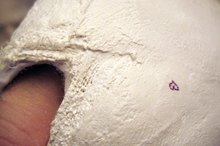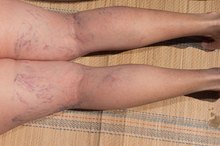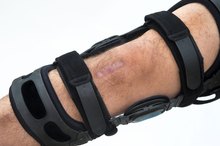The Signs & Symptoms of Vascular Problems in the Legs
Vascular problems of the leg can affect the arteries, which bring blood to the legs, or the veins, which carry blood back to the heart. The symptoms are varied and depend on what kind of vessels are involved and the type of damage that occurs. While conditions, such as varicose veins, mainly cause cosmetic problems, other conditions, like deep vein thrombosis, cause complications that could end in death.
If you are experiencing serious medical symptoms, seek emergency treatment immediately.
Varicose Veins
Blood in the leg veins travels upward in the heart. This blood is prevented from going backward due to valves that allow it to only go one way. If these valves become weakened, varicose veins may develop. Varicose veins are dilated, tortuous veins that usually appear in the front of the legs. It is common in individuals whose professions require prolonged standing and in pregnancy. Prolonged cases of varicose veins can cause itching, discoloration of the limb and ulcers. Mild cases are treated with elastic stockings, but severe cases may need surgery.
- Blood in the leg veins travels upward in the heart.
- If these valves become weakened, varicose veins may develop.
Deep Vein Thrombosis
Why Is the Foot Swollen After a Leg Break?
Learn More
Deep vein thrombosis, or DVT, is a serious condition resulting from the formation of clots in the legs. The condition is most common after prolonged sitting. Patients with DVT may have mild symptoms of pain and swelling in the affected leg; however, most patients have no symptoms whatsoever. The clot may break free from the blood vessel, pass through the right side of the heart, and get lodged inside the lungs. This condition, known as pulmonary thromboembolism, may be fatal. The condition is usually treated with long term anticoagulation to prevent enlargement of clots in the legs.
- Deep vein thrombosis, or DVT, is a serious condition resulting from the formation of clots in the legs.
- The condition is usually treated with long term anticoagulation to prevent enlargement of clots in the legs.
Arterial Embolism
This condition may be considered the opposite of deep vein thrombosis. In patients with heart conditions, such as atrial fibrillation, clots may form within the heart; these may then dislodge and cause obstruction in the arteries of the leg. Arterial embolism is characterized by sudden onset of pain from the leg. Patients will be unable to move the leg and may have loss of sensations 2. Pulses in the leg may be lost and the limb may feel cold. These patients often need amputation of the limb to prevent loss of life.
- This condition may be considered the opposite of deep vein thrombosis.
- Arterial embolism is characterized by sudden onset of pain from the leg.
Chronic Arterial Disease
Causes of Temporary Leg Paralysis
Learn More
Chronic arterial disease is most commonly due to atherosclerosis of the arteries that supply the leg. This is commonly seen in the elderly population. Buerger's Disease is seen in middle-aged smokers and is a less common cause of chronic arterial disease. Patients may complain of burning pain coming from the toes and may develop ulcers at these sites. In addition, patients will have muscle wasting, loss of hair on the limb, and loss of pulses. Many of these patients can be treated with placement of a stent in the vessel or with a bypass operation.
- Chronic arterial disease is most commonly due to atherosclerosis of the arteries that supply the leg.
- Patients may complain of burning pain coming from the toes and may develop ulcers at these sites.
Related Articles
References
- "Davidson's Principles and Practice of Medicine"; Nicki R. Colledge et al.; 2010
- "Bailey and Love's Short Practice of Surgery"; Normal S. Williams et al.; 2008
- Raetz J, Wilson M, Collins K. Varicose veins: Diagnosis and treatment. Am Fam Physician. 2019;99(11):682-688.
- Critello CD, Pullano SA, Matula TJ, De Franciscis S, Serra R, Fiorillo AS. Recent developments on foaming mechanical and electronic techniques for the management of varicose veins. Expert Rev Med Devices. 2019;16(11):931-940. doi:10.1080/17434440.2019.1682549
- Epstein D, Onida S, Bootun R, Ortega-Ortega M, Davies AH. Cost-effectiveness of current and emerging treatments of varicose veins. Value Health. 2018;21(8):911-920. doi:10.1016/j.jval.2018.01.012
- American Academy of Dermatology. Leg veins: Why they appear and how dermatologists treat them.
Writer Bio
Sriram Ramgopal is a medical graduate from Sri Ramachandra University, India. He currently lives in the the greater Boston area and works as a Neurology Research Fellow at Children's Hospital, Boston. Ramgopal is also the co-founder of Sangam India, a nonprofit urban development organization based in Chennai, India.









